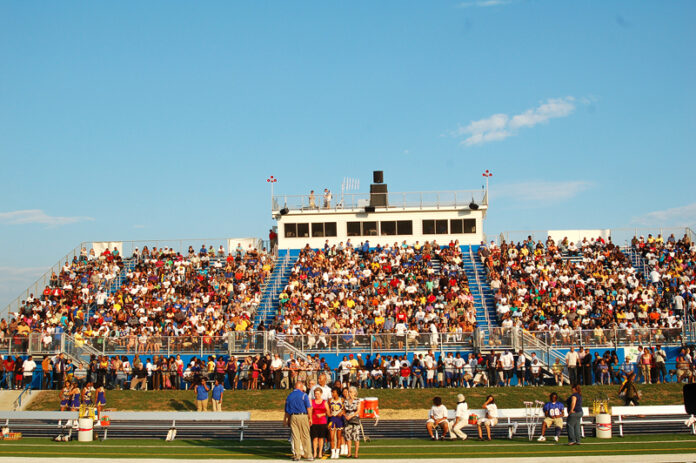
“We finally have a place to call home,” said William Fleming High School athletic director Matt Kesler, sounding a theme heard several times as they cut the ribbon at “Colonels Stadium,” last week. The 3100 seat, expandable football stadium, which includes a rubberized track capable of holding competitive meets opened with a football game against E.C. Glass later that night. (Alas, Fleming lost that tilt 14-6.)
A handful of former Fleming football coaches were on hand for the stadium dedication, including Don Lee and George Miller. Until now Fleming had played all of its home games at Victory Stadium, or at Patrick Henry’s new stadium over the past few seasons. The $8 million dollar complex at Fleming also includes practice football fields, soccer fields, tennis courts and softball / baseball fields that will be ready next spring. “Sometimes dreams do come true,” said School Superintendent Rita Bishop.
“It’s a new day at William Fleming,” added principal Gene Jones – himself new on the scene. “We’re going to make this a place you can all be proud of.”
City Council member Dave Trinkle, perhaps alluding to the Victory Stadium versus on- campus football field debate, called last Friday’s ribbon cutting the end of a “long 20 year process. It’s taken many school boards, many City Councils, a lot of dedicated staff and volunteers to see this through. Even the naysayers are going to have a hard time saying this wasn’t the right thing to do. It was worth the battle.”
Former Roanoke City Councilman Alfred Dowe Jr. called it “a great day for Northwest Roanoke. A lot of sacrifices were involved with moving forward.” Dowe, who was elected in large part because he supported on- campus stadiums instead of Victory Stadium renovations, said he received several death threats because of his position. “All in all it worked out well,” said the Fleming graduate.
One unique feature: electricity-generating wind turbines are mounted to the stadium light poles. Architect Richard Rife said that was a first – in the country. Power generated over the past six weeks has gone back into the electrical grid, saving the school system money.
As for the stadium itself, “we wanted to make it a good experience for the fans,” said Rife. Roanoke School Board chairman David Carson pronounced the project “complete [and] under budget,” when he spoke briefly. “Really impressive stuff.”
Hall of Fame: Many of the ribbon cutting dignitaries and attendees then went over to the school’s cafeteria, where the initial William Fleming Athletic Hall of Fame class was introduced. The first group of ten included former football stars (Lee Suggs, John St. Clair), coaches (George Miller, Fred Smith, Lynn Agee) and other student athletes like basketball standout Charlene Curtis.
The new football stadium was still the subject of much conversation at the Hall of Fame reception. Troy McGeorge, who helped organize the Hall of Fame project, called it “one of the best things I’ve seen in my lifetime to bring this community together.” As for the Hall, his goal was to tie the three-campus legacy of William Fleming together and recognize past athletic standouts. “A long time coming,” he said. In future years no more than five new members will be voted in to the Hall at one time.
“These kids deserve it,” said Miller of the new stadium. He took the 1997 Colonels team to a state football title game. “Fleming should also have a real gridiron advantage now for home games,” said the recently retired administrator. “It’s hard for other teams to play in your back yard.”
Charlene Curtis played basketball in the old gym at Fleming, which was torn down to make way for the new sports complex. She later played at Radford University and coached at Wake Forest. Being elected to the initial class of the William Fleming Athletic Hall of Fame “was a humbling experience,” for Curtis, who now oversees game officials for several conferences.
Fellow inductee Lynn Agee was Curtis’s coach and Miller was her “idol” as a musician. “People need to know their history,” said Curtis, hoping that hallway displays of memorabilia will let current Fleming students know more about the school’s rich athletic history. “It’s hard to have school spirit if you don’t know what happened before,” said Curtis.

